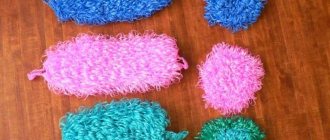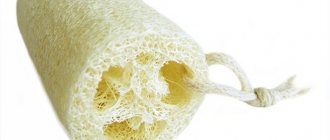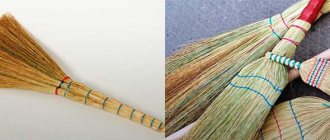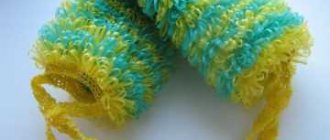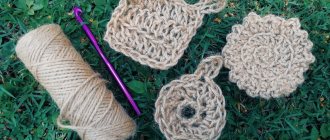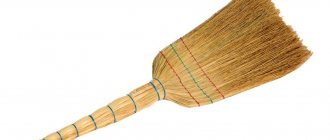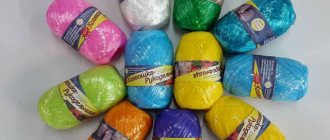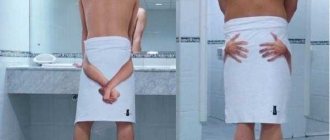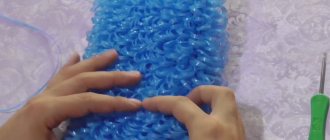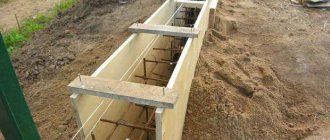What material to use
You can purchase both natural and artificial threads. Materials of natural origin will make the grater a little more useful, but such things do not have a long service life.
Threads are sold in any market, so purchasing them is not a difficult task. You have to choose from the following fabrics:This is interesting: things knitted from synthetic thread have an impressive service life, up to one year.
Round washcloth for washing dishes
You can knit a small washcloth from scratchy synthetic threads or a rope for washing dishes.
- Tie a rectangular pipe using the method described above.
- Sew the edges together using a smaller crochet hook.
- Thread the thread through one corner of the workpiece and pull it through the opposite one.
- Pull the workpiece, you should get a ball with folds.
- Secure the thread and make a loop for hanging.
With the help of a hook and imagination, you can make a wide variety of washcloths in appearance and purpose. And if you take used bags rather than purchased yarn, you will not only decorate your home, but also help the environment.
Capron
Women's tights that have become unusable can find a second life. Describing such crafts from scratch does not take much time. Creating nylon graters is very simple.
Note!
- Patterns for knitting overalls for a newborn: step-by-step master class
How to crochet a mouse and a rat: video master class on crocheting the 2020 symbol
How to knit a warm hat with ears for a newborn boy and girl - video tutorials with patterns, instructions for beginners
Acrylic
Robust and reliable structure with an impressive service life. You can also knit a pole with your own hands from jute. You can use manila fiber, burlap, rayon and nylon.
Important! The tied pole, after completing work on it, must be boiled in hot water for about 10-15 minutes.
This way you will make it softer and eliminate possible “factory” bacteria and odors. It is important to choose a high-quality tool, starting from the rigmarole used. We recommend choosing hooks with a round end.
Loofah ball
Beginning knitters can knit a round washcloth, much like store-bought washcloths. Beautiful folds that form the ball are obtained by knitting several loops from one.
- Cast on 6 loops.
- Knit 2 rows of regular stitches.
- In the third row, knit three new loops from each loop.
- Repeat the increase for three more rows.
- Knit a row of settlements with single crochets.
- Knit a chain of loops for the handle of the washcloth.
- Sew the washcloth to prevent it from unraveling during bathing.
To make a round washcloth more voluminous, you can use double crochets instead of simple stitches.
Types of washcloths
Many girls and women are simply unable to take a bath without such a bath accessory. A good and tough tap does an excellent job of ridding the body of dead skin cells, and also allows you to cleanse the pores and skin.
Note!
How to crochet a beautiful scarf: video master class on creating unusual, beautiful, simple scarves for boys, girls, men and women
How to knit a hat with a lapel using knitting needles or an elastic band: step-by-step instructions for beginners
- How to crochet a winter hat: 95 photos of new models of warm, fashionable, original knitted hats with a lapel and a beautiful pattern
Bath milk, shampoo or scrub are added to such procedures. By giving a similar gift to a woman and attaching a hand-knitted VEKHOT to it, you can make your mother or grandmother incredibly happy. We'll tell you how to learn how to do such things.
With hard and soft sides
At first glance, you might think that the method of knitting washcloths is a rather difficult craft, demanding on the skill level of the master.
However, this is not so - you can get ready-made needlework using a diagram and step-by-step instructions, adding to them a little attentiveness and perseverance.
The main skill that will be useful to you in business is the skill of knitting shaggy stakes. Before starting the lesson, you can practice and get your hands on a little.
To create a double-sided model, it is best to use hook No. 4. The fabric used is polypropylene thread, absolutely any kind.
Note!
- How to knit a beanie hat correctly with knitting needles: video master classes, patterns, knitting patterns for fashionable models
Light and beautiful crochet shawl: photos of chic openwork scarves with simple patterns
- Turban hat with knitting needles: how to knit a turban with your own hands, patterns, video master class with step-by-step instructions
You choose the color of the product yourself - you can make it in one tone, or choose several colors.
Please note: one surface will be pleasant, while the other will be dense and hard. The first one must be woven lengthwise, the second one – across.
Step by step guide:
- First, you need to complete a chain, which determines the horizontal size.
- The first and second lines are knitted from S/BN.
- The third line will be different for colored and plain washcloths. If you have a variegated model, you need to knit an air loop using two threads, then make two S/BN stitches and finish with a fluffy stitch. The last column is recreated from the chain from which the length was determined.
- To create a fluffy column you need 5 bars with a CAPAGE, secured using a weightless buttonhole. Then three cap pegs are knitted, and the procedure for creating a lush column is repeated again. You will have to weave in this way until the end of the column.
- In the fourth column, an air buttonhole is constructed, then you need to move on to the non-cap posts, placing them in the buttonholes of the previous section. If your creation has more than one color, the last buttonhole is secured with two threads.
- The fifth is knitted with yarn of the very first color, including a weightless buttonhole. Then you need to move on to alternating: 3 sc and a lush post. As a result, you will get a hedgehog washcloth.
- The sixth line is scored in the same way as the fourth.
- The seventh row is different if your item has several colors. In this case, at this stage, yarn of the next color is taken. Weaving is similar to the fifth line.
- The eighth row completely repeats the fourth.
- The design continues until you reach the required dimensions established by the very first chain. As you may have noticed, looped thread is the most important skill for knitting washcloths.
Their alternation occurs not through three columns, but through two. When you complete the second section, both planes are applied to each other and sewn together from the wrong side.
You can tie the completed creation along its entire length using a hook. All that remains is to add handles, which can be made from cotton ribbon.
Tip: do not forget to boil the finished washcloth - this will add softness.
Features of crocheting polypropylene threads
Polypropylene thread has a special structure. It has a number of advantages over other threads, such as:
- strength;
- elasticity;
- volumetric mass, with minimal weight;
- resistant to hot water;
- does not wear out;
- does not deform;
- has antistatic properties;
- environmentally friendly.
All this determines the type of products that are knitted from propylene threads and the knitting methods themselves. The first thing you should pay attention to in yarn is the thickness of the thread. It can be determined at a glance, but in order to choose the right hook for the yarn, you should pay attention to the ratio of the length of the thread and the weight of the skein. You can take the hook that is indicated on the skein of thread.
The optimal fiber length for a washcloth is 250 m per 50 g.
For rugs and bags, you can choose thicker threads. This is especially true for rugs. The length of the thread in the skein in this case should range from 150 to 200 m per 50 g. Although, in principle, you can achieve tighter knitting if you choose a thinner hook. This way the density of the loops will become higher and the whole knitting will become a little denser and thicker.
"Bumps"
This is a beautiful and colorful handicraft, which is a real pleasure to use. For this task you will need to use equipment No. 5 and yarn of several colors.
The procedure consists of weaving a line of thirty-six loops, which is subsequently secured into a circle.
Step by step guide:
- The first row is created using single crochet risers.
- From the 2nd to the fourth line it is worth taking cap columns.
- The image of cones is used as the main image of the washcloth. They are created to a maximum horizontal level determined by the wizard. The element consists of three yarn overs woven together. The cones alternate through two risers. Tip: The oval pattern should be staggered.
- Since the “circle” weaving model is used, you should finish the needlework according to the same pattern in which you started, only in reverse order.
- If you want to create handles, you can go two different ways: knit them separately and secure them, or start working on one and then move on to the second. The choice is yours.
Polypropylene
Polypropylene is one of the newest petroleum-based synthetic fibers. The fiber has good insulating properties, and its production is very economical and easy. Polypropylene yarn is close to wool and has less electrification compared to other synthetic fibers.
History of the discovery of polypropylene
In the last century, the German scientist Otto Bayer developed the theory of creating artificial materials. A few years later, another organic chemist, Karl Ziegler, together with the Italian specialist Giulio Natta, discovered metal complex catalysis of polymerization - then it became possible to synthesize polypropylene.
The material is obtained as a result of a chemical reaction where metal complex catalysts are present, which are named after their discoverers - “Ziegler-Natta catalysts.”
Production of polypropylene yarn
The yarn is made from a polypropylene solution using a special technology of pressing the molten material through the forming holes of the extruder. To obtain thin yarn-like threads, the streams of the melt itself must be cooled by a flow of air and harden.
Great importance is paid to the structure of the fiber. Cut material is popular in the manufacturing process. For production, short threads are used, which cannot be used on their own. Small lengths are cut into even shorter lengths, then twisted to give the yarn a uniform diameter. The result is a voluminous material that is suitable for weaving carpets.
Non-breaking threads can also be used in the production process. They already have a single diameter and are characterized by increased wear resistance. Products made from such material are not subject to pilling or felting.
Material properties
The most reliable description of polypropylene yarn can be given by needlewomen, whose opinion is formed during the work process. They unanimously agree on the following qualities of the material:
- high resistance to microorganisms;
- variety of color palette;
- good dimensional stability;
- strength and durability;
- moisture resistance.
You can also add your own point to the description, especially since hand knitting from polypropylene yarn is a very exciting process. Unusual material in itself is an inspiration for creativity. By thinking about its use and creating a unique thing, you improve your skills and abilities.
Rules of care
Products made from polypropylene yarn do not require special care, which in itself is another advantage of the material. Strong resistance to stains allows you to rarely resort to washing, which, you see, cannot but please craftswomen. As a rule, all care consists of hand washing at a temperature not exceeding 30 °C. These products do not require ironing.
Advice. Use soap and vinegar as a cleaning agent. After wrung out the item and shaking it a couple of times, you can hang it on a drying rack or lay it out on a flat surface.
What is knitted from polypropylene
Perhaps the most common use for this yarn is knitting washcloths. And for good reason, because they cleanse and exfoliate the skin well, creating a scrubbing effect. You can create a whole collection of bath accessories - they will be distinguished by rich colors and originality. In addition to washcloths, the set can include a bath mat, a basket for small items, and a cosmetic bag.
Polypropylene yarn also finds its application in knitting house shoes, stands for flower pots, tablecloths, accessories, hats, women's beach bags, backpacks.
Where will your imagination take you?
Creating unique things from such yarn means not only giving inspiration to yourself and others, but also taking care of the well-being of those closest and dearest to you!
"Spiral"
Another beautiful flat product that is a pleasure to give and use. The spiral consists of a double line, each of which includes forty-seven loops, fastened in a circle.
Detailed instructions for making a circular crocheted washcloth:
- The first row is knitted from RLS. They need to be placed in each loop of the main line.
- 2 and all subsequent sections are performed with elongated loops attached to each block. As soon as you finish working on the six elements, you should take a thread of a different shade. The color change is ongoing.
- The pattern, also called a “fox”, is created by shifting the shade by exactly one buttonhole in each section. Dimensions in length can be absolutely any. The process should be completed with the use of RLS. The washcloth-mitten is ready!
What can you connect?
Propylene threads are suitable for knitting:
- washcloths;
- napkins;
- bags;
- rugs
You need to choose the thickness of the threads depending on the density of the finished product you want to obtain.
Bag
Propylene thread will make a great bag for the beach or shopping. The advantages of such a product are obvious - they do not get very dirty, since the dirt does not eat into the fiber itself .
And if the bag does get dirty, then washing it is very simple and, moreover, after this procedure it does not change its characteristics. In order to knit a medium-sized bag, you will need about 800 m - which is 4 skeins of 50 grams. thread The most important thing when starting work is to decide on the dimensions of the bag.
Choose a hook for the bag that is ½ size thinner than recommended on the skein of thread. This will help create a product that is denser and will not stretch under the weight of what will be inside.
It is important to understand what the length, thickness and height of the finished product will be. The bottom will determine the length and thickness of the bag. In order to get started, you need to knit a series of loops to the desired length. Then:
- Knit sequential rows in columns, best without crochets to the depth of the product.
- After this, tie the bottom with loops and continue knitting in the round to the desired height, that is, to the height of the bag. You can knit either with single crochets or with 1 or 2 crochets or any other patterns.
- After the bag itself is finished, you should knit the handles of the product and sew them to the bag. The number of options for a bag can be endless, since you can combine different colors and make different patterns. But the approximate diagram of a crocheted bag made of propylene threads looks like the one shown in the figure.
washcloth
For a washcloth, you need to take a propylene thread of a color so that it harmonizes with the overall interior of the bathroom.
For adults, you can take a thicker thread, while for a children's washcloth it is better to choose a thinner thread, it will be more gentle on children's skin. Before starting work, soak the threads in boiling water for about 5 minutes. This will make them softer and more obedient. First you need to decide what the washcloth will look like. There are two model options:
- Knitted as a flat oval piece with a loop attached.
- In the form of a pipe with loops attached to the ends for ease of use.
For a flat model, you must first determine the size of the washcloth and then crochet the number of loops along the length of the product . Knit one row alternately with simple stitches, while in the second row make elongated loops.
If a pipe washcloth is knitted, it is done according to this pattern. But it is worth considering that it is approximate, since the dimensions can be changed and also depend on the thickness of the threads.
Rug
A rug made of propylene threads will look great in the bathroom.
This product is easy to maintain and care for because it does not get dirty, is easy to wash, does not absorb excess moisture and does not accumulate it. To make such a product with your own hands using a crochet hook, it is enough to determine the overall dimensions - length and width . Then cast on either the length or width of the appropriate number of loops and knit until the desired size is obtained. The rug is knitted in single crochets in odd rows , while chain stitches are knitted in even rows. You can knit air loops in every third row, so the rug will not be too fluffy.
After the product is finished, the loops can be left as they were. Or you can cut each loop in half with scissors at the top point, so the carpet will not have a loop structure, but a thread structure.
DIY vase made of thread and glue
Satin ribbon star
Dish scrubber
Using knitting needles, you can knit flat sponges for washing dishes. Any synthetic material that is durable and reliable will do. You can work with a crochet hook or knitting needles.
For beginners, the simplest version is suitable - a scarf pattern. Its peculiarity lies in the need to knit loops in the front and back rows. Knitted sponges can also be in the form of mittens, which are convenient to work with.
For a thing with a diameter of about 10 centimeters, you should purchase only 20 grams of matter. It is better to choose a medium thickness gimp. The work is performed with instrument No. 4.
You can use structures of different shades to create a multi-colored pattern. In addition to the main tool, you will need scissors and a needle. On the Internet you can find many master classes and videos that will help you work on this creation.
Spiral sponge
This type of washcloth may contain 2 or more colors. It can be knitted either in a flat pattern or using the “grass” technique. Begin knitting with a set of 47 basic loops, which are closed into a ring.
The following are step-by-step instructions for knitting a washcloth:
- Knit one row with simple stitches.
- Knit 6 stitches of the row with the main color.
- Add extra thread. Knit the next 6 stitches.
- Knit the next 6 stitches again with the main color.
- Alternate colors until you reach the length you want.
- Finish knitting with a row of double crochets.
- Knit handles from the base loops and sew them on both sides of the washcloth.
Let's sum it up
This tutorial will help you knit a washcloth. As you may have noticed while reading, this is a fairly simple craft that can bring a lot of pleasure from the process itself.
A homemade item, enclosed in a beautiful package, will be an excellent gift option for March 8th or New Year. To truly please any woman, add shampoo, scrub or body milk to the grater. You can also knit children's washcloths-toys, with which you can surprise your kids. Good luck!
Baby hedgehog washcloth
Using the same technique of elongated loops, which is also called “grass” or “fur,” you can knit a simple baby washcloth. For babies, use soft natural yarn, and for older children, synthetics.
- Cast on 35 initial stitches and cast off the circle.
- Knit 2-3 rows with stitches.
- Next, knit 25-30 rows in the round with long loops.
- Attach an additional thread for the muzzle and continue knitting with it.
- In each row, decrease 4 loops until 1 loop remains on the hook.
- Close the knitting.
- Using the main color, embroider the nose and eyes of the hedgehog on the face.
The edges of the washcloth can be sewn together or the washcloth can be left hollow so that it can be placed on your hand.
How to knit a washcloth with your own hands: photo examples of the work of experienced needlewomen
Please repost
0
